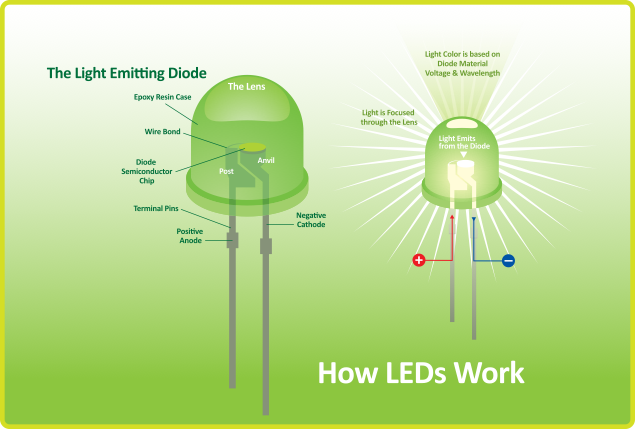Light-emitting diodes (LEDs) are advancing at the speed of light. Because of their high levels of efficiency and long source of life, they're becoming the preferred lighting source across the globe. According to industry forecasts, these bright little lights have advanced at remarkable rates to enable a new category of lighting that's predicted to reach $30 billion by 2025.
What makes LEDs stand out?
By now, LEDs have been lighting America's workplaces, businesses, and schools for years. Compared to other lighting sources, LEDs have many advantages. They're highly efficient, long-lasting, environmentally friendly, and easy to program and control. LED light sources are also gaining popularity because of the growing energy conservation movement. According to the U.S. Department of Energy, no other lighting technology offers as much potential to save energy and enhance the quality of building environments.
How do LEDs work?
Compared to the standard incandescent light bulb or the compact fluorescent lamp, the structure of the LED light is completely different-it's simpler and stronger. Because it's a diode, current can only flow in one direction. Just about any two conductive materials will form a diode when they come into contact, so when electricity is passed through the diode, the atoms in one material within the semiconductor chip are excited to a higher energy level. The atoms in that first material then have too much energy, which is released as the atoms shed electrons to the other material within the chip. This energy is what creates the light. The light-emitting semiconductor material determines the LED's color, since the color from the LED is a function of the materials and processes that make up the chip.

Image via doohresearch.com.
Why LEDs will light up the future
The average person uses lighting more times than they might even realize. When you open the refrigerator or car door, the light goes on, and with the flick of a switch, you can immediately light up a room. Drive down the city streets and see buildings and shops lit up, brightly advertising their presence. In the United States, lighting accounts for about 20% of all energy use.
Incandescent bulbs waste 95% of the energy flowing through them as heat, and though fluorescent bulbs are more efficient, their harsh color prevents them from taking over the lighting market. LEDs are long lasting and about 10 times more energy efficient than incandescent lights. Also, unlike other lighting sources, LEDs remain at room temperature, which can cut down energy use and trim your electrical bill.
For more information on LEDs, including safety and reliability of LED bulbs, surge immunity requirements of consumer LED lighting, and protection against temporary overvoltage, view the LED Design Guide by Littelfuse.
By Nicole DiGiose
Advertisement
Learn more about Electronic Products MagazineLittelfuse





